Nuclear explosives can be used to address many urgent issues: a shortage of mildly radioactive harbours, for example, or the problem of having too many wealthy, industrialized nations not populated by survivors who envy the dead. The most pressing issue—the need for a fast, affordable space drive—wasn’t solved until the late 1950s. Theodore B. Taylor and others proposed that the Bomb could be used to facilitate rapid space travel across the Solar System. Thus, Project Orion was born.1
The design of the Orion rocket is straightforward: detonate a series of nuclear explosives behind a pusher plate. The effective exhaust velocity would be much higher than any chemical rockets could provide. Unlike most plausible propulsion systems, the Orion could provide both high thrust with high exhaust velocity. At least, this is the way it would work in theory. For various reasons, from test ban treaties to the curious disinclination of people to tolerate increasing amounts of fallout, no working Orion was ever built. It remains a pipe dream.
George Dyson’s 2002 book, Project Orion: The True Story of the Atomic Spaceship, is the go-to popular work on Orion.
As any fan of Canada’s Avro Arrow could tell you, no machine is ever as splendid as the ones that have been proposed but never built. Fans can embrace all the potential of the hypothetical without worrying about any of the pesky problems that would certainly crop up in the real world. It is not surprising, therefore, that Orion rockets, many far more effective than the ones Taylor and company proposed2, began to show up in science fiction as soon as the concept became public knowledge.
Take, for example, these Disco- and Reagan-era novels—memories of a time when SF was surprisingly keen on the idea of traveling on top of a stack of exploding atomic bombs.
***
Farthest Star by Frederik Pohl and Jack Williamson (1975)
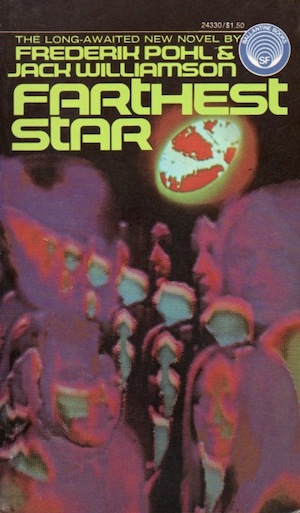
Object Lambda, an object as massive as a star, is passing through the Milky Way at a significant fraction of the speed of light. This demands investigation. Providentially, galactic civilizations can beam explorers across the Milky Way in the blink of an eye—provided the correct machinery is first delivered to the destination at sub-light speeds. The good ship Aurora has been diverted to deliver receivers to the enigmatic artifact.
Ben Perrin has the privilege to represent humanity on Aurora. This is a mixed blessing because among the amenities not present on the Orion-style craft is radiation shielding. Aurora provides its crew with abundant radiation. Thus, service is also a death sentence.
Not to worry. The marvelous technology Aurora will deliver to Lambda isn’t a teleport station; it’s a matter duplicator. If the current Ben Perrin should die—and given enough time on Aurora, he will—the authorities will simply run off as many copies as are needed to complete the mission. After all, it’s not as though the original Ben who volunteered for the suicide mission is the Ben who will die.
***
King David’s Spaceship by Jerry Pournelle (1980)
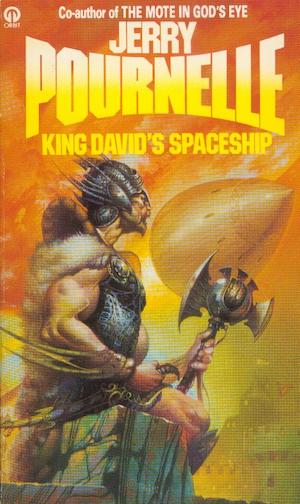
In the wake of the collapse of the First Empire, Prince Samual’s World balkanized into warring states armed with technology far inferior to that of the First Empire. The Second Empire is now ready to reintegrate Prince Samual’s World into an interstellar community. Thanks to technological disparities, how Prince Samual’s World’s population feels about becoming part of the Empire is irrelevant.
While they have no choice about being conquered by the Second Empire, precisely what status Prince Samual’s World will enjoy within the Empire is unclear. Worlds without indigenous space travel are relegated to the status of colonies. Worlds with indigenous space travel enjoy a far loftier position.
Prince Samual’s World’s steam-age technology isn’t up to space travel and the deadline when their world will be assessed looms. Without the time to develop space flight from scratch, Colonel Nathan “Iron” MacKinnie is dispatched to Makassar, where rumour has it that a First Empire library survives. Perhaps the library has some brute-force solution to orbital launches that is within Prince Samual’s World’s limited capacity. But time is running out and the backward natives of Makassar are disinclined to allow off-worlders to enter what is to them a holy site.…
***
Orion Shall Rise by Poul Anderson (1983)
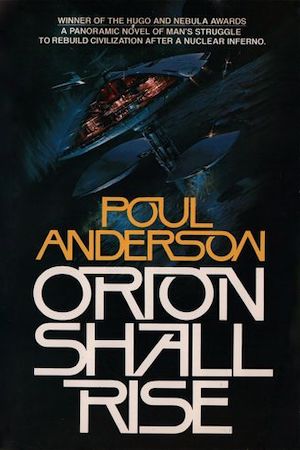
Centuries after the thermonuclear Downfall put an end to Western civilization, the world is well on its way to recovering the technology of the lost world. Technological sophistication is not matched by social progress—large swaths of the world are feudal states—while the exuberant industrialization of the 20th century depleted easy-to-reach natural resources. Thus, the civilizations of this world cannot easily recover the security and luxuries of the past.
The Maurai Federation believes industrialization was a mistake. It resulted in a poorer, poisoned world. As the world’s predominant power, they are in a position to make their stance general policy. When other nations try to upgrade, the Maurai step in to curtail the effort before it grows out of hand.
The Northwest Union learned this the hard way; it has been forced to heed Maurai taboos despite the Northwest’s current technological edge and urge to take it further. Determined to break free of Maurai shackles, the Union sets out to recreate a world-changing technology based in ancient myth. All they need is time and a sufficient supply of forbidden fissionables. And if there was one thing the old world was good at, it was leaving caches of lethal material scattered across America. Pity so much of North America is enemy territory…
***
Emprise by Michael Kube-McDowell (1985)
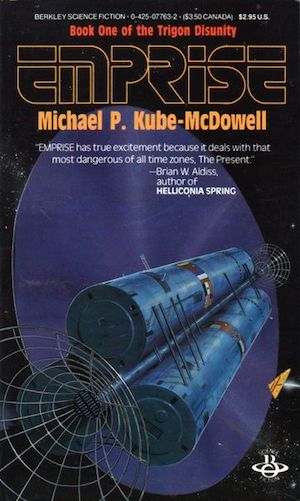
The Weak Force Intermodulation Projector—AKA the fission blanket—freed the world from the threat of thermonuclear war. The fission blanket also liberated the world from the easiest replacement for dwindling fossil fuel supplies. The Food and Fuel Wars that followed were arguably only superior to nuclear war because they didn’t leave the world poisoned by fallout. People still died in the hundreds of millions, and nations were still shattered.
A world emerging from a brief dark age is astounded to receive a message from the stars. Earth is about to have an extra-solar visitor, in the form of a nuclear-pulse-driven starship. A balkanized world would be ill-suited to resist the enigmatic visitors should they prove hostile. Nothing for it, therefore, but for a broken world to find some way to present a united face to the mysterious Galactics.
***
Marooned in Realtime by Vernor Vinge (1986)
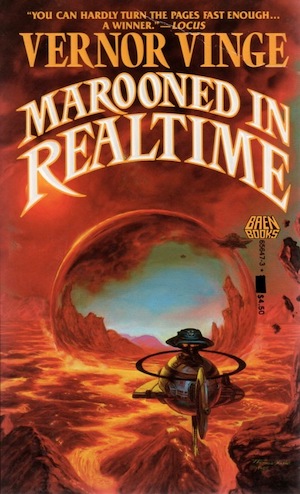
The Peace Authority used bobbles—spheres of frozen time—to conquer the world in the name of peace. Long after the Authority’s fall, humanity uses the bobbles in far more creative ways. Bobble-equipped Orion-style rockets can, for example, withstand the nuclear explosions of their propulsion systems and protect the passengers from the passage of time during long trips. Cheap, convenient space travel is just one aspect of the wonders of late humanity.
Pity that those cunning humans went extinct.
A handful of survivors protected within bobbles evaded whatever erased humans. They are equipped with impressively advanced technology, which doesn’t compensate for their dwindling numbers…because it seems an ancient human habit has made its way into the far future: murder.
***
I have no doubt many of you have your own favourite examples of fictional Orion drives—the only kind we have—and are even now preparing to descend on me for overlooking them. Have at it in the comments below.
In the words of Wikipedia editor TexasAndroid, prolific book reviewer and perennial Darwin Award nominee James Davis Nicoll is of “questionable notability.” His work has appeared in Publishers Weekly and Romantic Times as well as on his own websites, James Nicoll Reviews and Young People Read Old SFF(where he is assisted by editor Karen Lofstrom and web person Adrienne L. Travis). He is a four-time finalist for the Best Fan Writer Hugo Award and is surprisingly flammable.
[1]As a teen, I first read about Orion tech in John McPhee’s 1974 The Curve of Binding Energy (https://www.goodreads.com/book/show/54968.The_Curve_of_Binding_Energy). I was enthralled.
[2]Granted, some of the Orion-derivatives were pretty ambitious, like the 240-million-ton ship, with a pusher 150 km in diameter, that would accelerate for 30 years before a 150-year journey to Alpha Centauri.










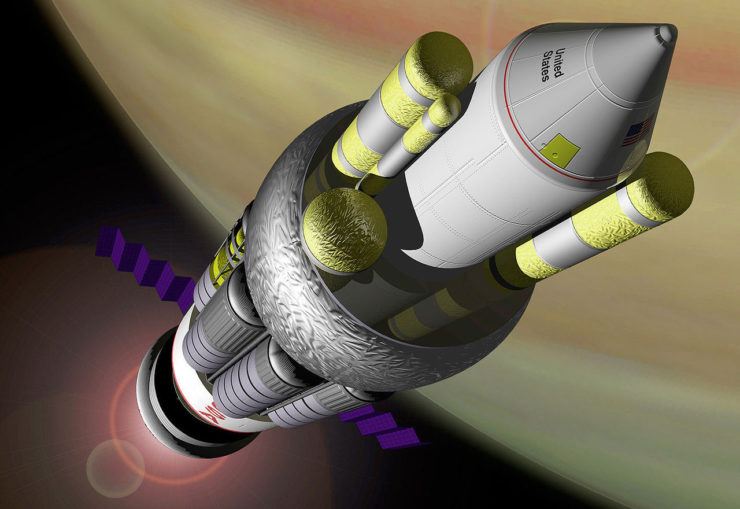
Neal Stephenson’s Anathem (2008) features an Orion-style habitat ship.
Hugh Walters (Walter Llewellyn Hughes) moved on to Orion-style drives in the later and more far-flung of his UNEXA stories, beginning with Passage to Pluto. (Actually, at that point, having run out of planets in the solar system, the story moved on to other kinds of adventures, but the atomic drives still featured occasionally.)
Evacuate Earth evacuates Earth via the use of an Orion-propelled habitat after a neutron star goes dingo.
I’m surprised you left out Footfall. Too obvious? One Pournelle book in the list was enough?
Any author gets one spot plus Footfall would be better served either as “books that have an exaggerated idea about the effectiveness of orbital bombardment” or “examples of why people should be very cautious about calling for very sexy sexing in SF.”
King David’s Spaceship was originally published as A Spaceship for the King with this rather grumpy fellow on the cover.
This version ended rather abruptly in the middle of the story.
Was Footfall “Invasion of the Baby Elephants With an Incomplete Instruction Manual?” I seem to have completely forgotten the sexy sexings in that. (I remember some weirdly human chauvinist possessiveness over the rings of Saturn specifically, and the disconcert of aforementioned Baby Spce Elephants when they realized that humans didn’t know how to surrender properly.
King David’s Spaceship didn’t use an Orion drive though. It was a Verne style Giant Cannon.
I think the speaker is wrong to claim it is not a rocket but the description makes it plain this is a crappier version of Orion.
In “The Oppenheimer Alternative” by Robert J. Sawyer an Orion drive ship was being developed but never used in the novel; it was heavily implied it would be used in the future. I wonder why I read a book with that title…
9: That was my recollection – King David’s Spaceship had an Orion-type launcher using chemical explosives, i.e. not powered by atomic bombs. Whether any chemical explosive provides enough thrust to lift the ship and the remaining supply of chemical explosives is an exercise for the reader.
USAns spent so long celebrating Robert Goddard’s “firsts” in liquid-propellant rocketry that few know he had previously wasted several years on solid-fuel engine designs that fed a rapid succession of fast-burning “cartridges” into the combustion chamber, varying thrust by changing the feed rate. He researched machine guns and (no kidding) the works of soft-drink vending machines and bottling-plant conveyor systems. A major reason was that he thought the precise “plumbing” for liquid propellants would not play well with the thermal and dynamic stresses of rocketry; he discovered that the precise mechanical engineering of belts, cams, etc. liked those stresses even less.
Ben Perrin appears to work for the same company as Sam Bell in Moon.
@11, that’s probably true for Earth, at least without a lot of staging. And they were already testing ballistic rockets, so why not stage those?
On the other hand, what if Samual’s World had significantly lower gravity than Earth? I haven’t done the math, but a couple dozen percent could be a game-changer.
Though I haven’t read it yet, Stephen Baxter’s Ark has a Project Orion ship, as I found in Google Books. It appears that the plan was to fly from Earth to Jupiter orbit by Orion, then discard the Orion engine and use something else for the interstellar leg?
Oh, I think I read that. I think the second drive was the sort of space warping superdrive civilizations inevitably develop when they are on the brink of extinction.
Neal Stephenson put one in Anathem, the funny thing was that in their world the equivalent drive wasn’t built but we on La Terre did build one to punch into their universe.
IIRC the drive in Emprise wasn’t an Orion-type, though you might think that from looking at the cover. I believe it worked by generating an gravity field in front of the ship that pulled the ship along after it. It had an equivalent generator in the rear for slowing the ship down. Looking back at it now I wonder why he didn’t have them just turn the ship around and use the same field. I may be misremembering something.
From the relevant section of Emprise:
In the Arrow’s defense, more of them were built than of Orion-drive spacecraft.
Pournelle also had an Orion Drive in his story that was to appear in the Last Dangerous Visions anthology, and only recently was published in the retrospective Best of Jerry Pournelle retrospective, edited by John Carr. Like the Footfall ship, it was launched from the Earth’s surface. He apparently enjoyed writing stories where people trashed the environment.
You would think that these spaceships would have even more trouble than most in getting rid of excess heat.
Drop 4-5 nukes, then wait a LONG time for things to cool. Or else the drive plates melt. Or something. Then another 4-5.
Let’s not forget the Messiah from the film Deep Impact which brought onboard a Russian Cosmonaut to handle the nuclear propulsion system.
JReynolds: most of the designs would spray an ablator over the pusher plate before the bomb went off. This would keep the plate from melting (the vaporized ablator would carry off the heat). They also would use nuclear shaped charges to direct a jet of gas at the plate, rather than exploding a bomb right on the plate.
Development of a system that can’t be tested other than all at once, at full scale, would have been an utter nightmare.
King David’s Spaceship used chemical high explosive bombs, not nuclear. They didn’t have that technology. It had a cannon on the aft end that fired the shells. It worked like the (original) Orion test vehicle. I would think it would have a horrible mass ratio, but maybe the planet in question was supposed to be less massive than Earth. I don’t recall if that was mentioned.
John Ringo’s Live Free or Die series had Orion powered “spaceships”. If you consider a spaceship, a gigantic asteroid.
Marooned in Realtime was a favorite in the ’90s. Stasis fields–bobbles–let people travel forward in time minutes, years, millenia, safely protected in a sphere in which no time passes. So nuclear propulsion is possible, as are nuclear skirmishes with participants popping in and out of time. Not the main focus of the book, which has some other well-thought out wonders.
It’s not in print/ebook yet, but Invisible Sun by some guy named Stross is due to be published by Tor on September 28th. A significant amount of the story happens on board an Orion-type nuclear pulse-detonation powered spacecraft, although I should probably not say anything more because [SPOILERS]. Based as closely as I could on plausible variants derived from the original Project ORION studies …
(It’s the several-years-overdue last book in the Merchant Princes/Empire Games series, book 9 or book 6 depending how you count them. Delayed due to multiple real-world deaths and then COVID19, but finally on its way into orbit around a parallel universe Earth in a 2020 that didn’t happen.)
@19, I didn’t realize that in the article you were talking about the alien ship that Earth was going out to meet. I had actually forgotten about that one. I haven’t read the series since it was first published. The Earth-built ships did use an artificially generated gravity well, and I believe that is what is depicted on the cover.
For a recent take on Project Orion ships I recommend this recent posting on the ToughSF blog: https://toughsf.blogspot.com/2021/01/moto-orion-mechanized-nuclear-pulse.html
@28 cstross
This “Stross” guy, did he write anything else? Where might be a good place to start with them?